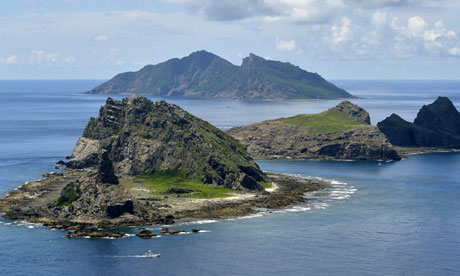|
Tech
Business |
|
Sep 18, 2012 |
|
By
Willard Foxton |
|
|
|
 |
|
| The Senkaku Islands:
not much of a holiday destination (Photo: AP) |
|
In
Baotao, inner Mongolia, a huge mine operates day and night.
Workers in chemical suits hose acid into tunnels. Huge
posters bearing images of smiling employees proclaim "Become
the leader in Rare Earth mining!" as huge refineries and
factories belch smoke into the sky. Yet this huge centrally
planned project is in danger because of events thousands of
miles away.
You
probably haven't heard of the Senkaku islands. Or, as they
are known in China, the Diaoyou islands. Called the Pinnacle
islands on British naval charts, they are a collection of
uninhabited, barren rocks, home to a rare albatross and a
exceptionally rare type of mole. Not a great holiday
destination.
Last week,
Japan arranged to buy the Senkaku
islands from their private
owners. There was uproar in China. In Beijing, cars were
burned and Japanese businesses were attacked, and riots in
Shenzen. The Senkaku/Diaoyou dispute has long been a
flashpoint between the two nations. Every few years,
ultra-nationalists from either side (or, indeed,from Taiwan,
who also claim them) will sail out there, raise a flag, and
cause a row.
However, it's never been this serious before. Regardless of
silly orientalist ideas about "losing face", a quick glance
at a map reveals why the governments care about these rocks.
The islands are mid-way between Japan and Taiwan; a Chinese
base there would push the range of carrier-killing ballistic
missiles an extra four or five hundred miles into the
Pacific.
The
Chinese government has issued threatening statements, and
the Japanese government has threatened right back, ominously
declaring they had US support for nationalising the islands.
Currently, Chinese and Japanese gunboats are steaming
towards the islands and everyone in the Pacific is holding
their breath. However, you may be asking why you, or the
mine workers at Baotao, should care. After all, it is
unlikely to come to a shooting war.
The
mines at Baotao have slowed production in the light of the
Diaoyou situation; they provide around 99 per cent of the
world's supply of rare earths. Indeed, the Chinese
government has explicitly stated it will not allow the
shipping of these rare earths to Japan, which currently
consumes around 60 per cent of Baotao's output.
Those
rare earths, shipped from Mongolia to Japan, go into
practically every gadget we buy or make. Almost every
flatscreen TV, every mobile phone, everything that requires
memory, requires parts made in Japan with Chinese minerals.
The Japanese can't switch suppliers or buy the elements from
somewhere else for more money. No rare earths, no
manufacturing.
It's
not just the gadget industry, either. In news that will
delight my colleague James Delingpole, the renewables
industry is also dependent on the mines of Baotao. You can't
make a Prius battery or a wind turbine magnet without
Neodymium mined there and machined in Japan.
The
Japanese have been aware of this nightmare scenario for some
time; indeed, they've invested in sci-fi schemes such as
underwater rare earth mining to try to wean themselves off
their dependence on Chinese minerals. Unfortunately, the
crisis has blown up before these projects could bear fruit.
If the
crisis around the Senkakus, there will be huge consequences
for all of us, as supply chains all over the world break at
the Japanese link. For all our sakes, let's hope this
dispute is resolved quickly. |





